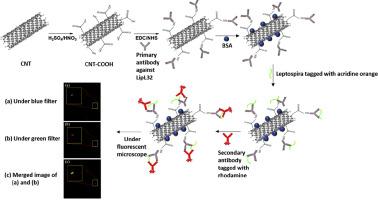Journal of Bioscience and Bioengineering ( IF 2.3 ) Pub Date : 2020-07-13 , DOI: 10.1016/j.jbiosc.2020.06.002 Kannan Sapna 1 , Mohammed Tarique 2 , Ashaiba Asiamma 2 , Terikere Nagaraj Ravi Kumar 3 , Vishwanath Shashidhar 3 , Ananthapadmanabha Bhagwath Arun 2 , Kariate Sudhakara Prasad 4

|
Leptospirosis is a widespread zoonosis and an emerging public health problem. Leptospirosis symptoms are often confused or misdiagnosed with other febrile illness like malaria, viral hepatitis, influenza, dengue, typhoid, melioidosis, and scrub typhus as the clinical manifestations are almost similar. Therefore, early and accurate diagnosis of leptospirosis is indeed critical for proper and prompt treatment. Herein, we report the development of single-walled carbon nanotubes based immunofluorescence probe (Carbo-Lip) for the detection of leptospirosis at an early phase by utilising major outer membrane protein, LipL32 of Leptospira. The Carbo-Lip probe was fabricated through immuno recognition method with fluorescent dye functionalized LipL32 monoclonal antibodies (mAbs), secondary antibody and Leptospira. Surface characterization studies such as Fourier transform infrared spectroscopy with the attenuated total reflectance, scanning electron microscopy, transmission electron microscopy, Zeta potential, and X-ray photoelectron spectroscopy techniques were used to demonstrate the successful fabrication of Carbo-Lip probe. The sensor probe was capable of detecting the presence of leptospires at a lower concentration of 103/ml, and could detect 102 leptospires in 100 μL of sample within 3 h of the test conditions, and was stable up to 2 weeks. This Carbo-Lip probe was further tested and validated for its capacity to detect Leptospira in clinical samples, which exhibited high selectivity and specificity towards Leptospira even in the presence of malaria and dengue. Our results were consistent with microscopic agglutination test, which is known as gold standard, immunoglobulin M (IgM) enzyme-linked immunoassay (ELISA), IgM spot test, and culture tests for the diagnosis of Leptospira infection.
中文翻译:

使用Anti-LipL32碳纳米管免疫荧光探针早期检测钩端螺旋体病。
钩端螺旋体病是一种广泛的人畜共患病和新出现的公共卫生问题。钩端螺旋体病症状通常与其他高热疾病相混淆或误诊,例如疟疾,病毒性肝炎,流感,登革热,伤寒,乳突病和灌木斑疹伤寒,因为临床表现几乎相似。因此,对钩端螺旋体病的早期和准确诊断对于正确和及时的治疗确实至关重要。在本文中,我们报告了单壁碳纳米管免疫荧光探针(Carbo-Lip)的开发,该探针可通过利用主要的外膜蛋白,钩端螺旋体的LipL32在早期检测钩端螺旋体病。Carbo-Lip探针是通过免疫识别方法用荧光染料功能化的LipL32单克隆抗体(mAbs),第二抗体和钩端螺旋体。表面表征研究(例如具有衰减的全反射率的傅立叶变换红外光谱,扫描电子显微镜,透射电子显微镜,Zeta电位和X射线光电子能谱技术)用于证明Carbo-Lip探针的成功制造。传感器探针能够以10 3 / ml的较低浓度检测钩端螺旋体的存在,并且在测试条件下的3小时内可以检测100μL样品中的10 2个钩端螺旋体,并且稳定至2周。对该Carbo-Lip探针进行了进一步测试并验证了其检测临床样品中钩端螺旋体的能力,该样品对钩端螺旋体表现出高选择性和特异性即使在疟疾和登革热的情况下。我们的结果与被称为金标准的显微凝集试验,免疫球蛋白M(IgM)酶联免疫测定(ELISA),IgM斑点试验以及用于诊断钩端螺旋体感染的培养试验一致。











































 京公网安备 11010802027423号
京公网安备 11010802027423号